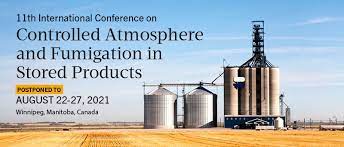Ver ítem
- xmlui.general.dspace_homeCentros Regionales y EEAsCentro Regional Buenos Aires SurEEA BalcarcePresentaciones a Congresosxmlui.ArtifactBrowser.ItemViewer.trail
- Inicio
- Centros Regionales y EEAs
- Centro Regional Buenos Aires Sur
- EEA Balcarce
- Presentaciones a Congresos
- Ver ítem
Evaluation of fungicidal action of four products on external fungal biota of grains.
Resumen
Corn, the main crop in Argentina, is normally harvested and stored in silo bags above the safe storage moisture content for 3-6 months, and faces high risk of quality losses. The evaluation of fungicidal/fungistatic products that could potentially be used to protect wet grain stored in silo bags, has not been widely studied. Thus, the objective of this study was to make a preliminary in-vitro comparative evaluation of four different fungicidal treatments
[ver mas...]
Corn, the main crop in Argentina, is normally harvested and stored in silo bags above the safe storage moisture content for 3-6 months, and faces high risk of quality losses. The evaluation of fungicidal/fungistatic products that could potentially be used to protect wet grain stored in silo bags, has not been widely studied. Thus, the objective of this study was to make a preliminary in-vitro comparative evaluation of four different fungicidal treatments in corn: 1) propionic acid (3 L/t); 2) a quaternary ammonium compound (3 L/t, diluted 1:25 with water); 3) sulfur dioxide (initial dose: 15% v/v); 4) phosphine (initial dose: 6.6 g/m3) along with their respective controls (non-treated). In treatments 1 and 2 (liquids) corn was sprayed with the product and then stored in a sterilized glass jar. In treatment 3, sulfur dioxide was injected into a previously sealed glass jar. In treatment 4, glass jars were placed inside a plastic drum of 60 L capacity with two aluminum phosphide tablets (0.2 g phosphine each) and closed. Both liquids and the phosphine treatments had an exposure time of 15 d (at 25 ± 1°C), while in the sulfur dioxide treatment, three exposure times were evaluated (5 min, 5 and 24 h, all at the same temperature). After the various treatments, the fungal biota (molds and yeasts) was evaluated. The results showed that the propionic acid treatment achieved a total control of fungal biota. Treatment with sulfur dioxide showed a reduction of 2-3 log10 (CFU/g DM) compared to non-treated samples. Finally, the quaternary ammonium compound and phosphine treatments only achieved a reduction in the number of colonies of 1 log10 (CFU/g DM). Based on the results of this study, propionic acid seems to be a good solution for improving the storability of wet corn in silo bags. Nevertheless, more information should be generated at laboratory and full scales.
[Cerrar]

Autor
Alvarez, Estefanía;
Cardoso, Marcelo Leandro;
Bartosik, Ricardo Enrique;
Castellari, Claudia Carla;
De La Torre, Diego;
Erreguerena, Ignacio Antonio;
Abadia, María Bernadette;
Fuente
Proceedings of the 11th International Conference on Controlled Atmosphere and Fumigation in Stored Products. Canadá, 22-27 august de 2021
Fecha
2021-08
Editorial
University of Manitoba, Canadá
Formato
pdf
Tipo de documento
documento de conferencia
Palabras Claves
Derechos de acceso
Restringido
 Excepto donde se diga explicitamente, este item se publica bajo la siguiente descripción: Creative Commons Attribution-NonCommercial-ShareAlike 2.5 Unported (CC BY-NC-SA 2.5)
Excepto donde se diga explicitamente, este item se publica bajo la siguiente descripción: Creative Commons Attribution-NonCommercial-ShareAlike 2.5 Unported (CC BY-NC-SA 2.5)

